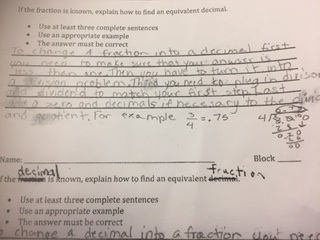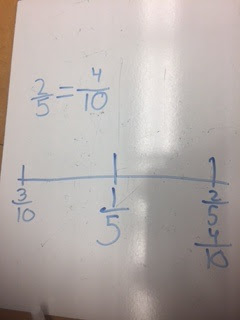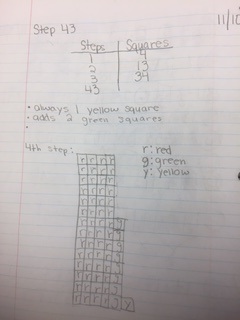6th Grade Math Standards: 4.NF.3 Understand a fraction a/b with a > 1 as a sum of fractions 1/b. a. Understand addition and subtraction of fractions as joining and separating parts referring to the same whole. b. Decompose a fraction into a sum of fractions with the same denominator in more than one way, recording each decomposition by an equation. Justify decompositions, e.g., by using a visual fraction model. Examples: 3/8 = 1/8 + 1/8 + 1/8 ; 3/8 = 1/8 + 2/8 ; 21/8 = 1 + 1 + 1/8 = 8/8 + 8/8 + 1/8. c. Add and subtract mixed numbers with like denominators, e.g., by replacing each mixed number with an equivalent fraction, and/or by using properties of operations and the relationship between addition and subtraction. d. Solve word problems involving addition and subtraction of fractions referring to the same whole and having like denominators, e.g., by using visual fraction models and equations to represent the problem.
5.NF.1 Add and subtract fractions with unlike denominators (including mixed numbers) by replacing given fractions with equivalent fractions in such a way as to produce an equivalent sum or difference of fractions with like denominators. For example, 2/3 + 5/4 = 8/12 + 15/12 = 23/12 . (In general, a/b + c/d = (ad + bc) /bd.)
5.NF.2. Solve word problems involving addition and subtraction of fractions referring to the same whole, including cases of unlike denominators, e.g., by using visual fraction models or equations to represent the problem. Use benchmark fractions and number sense of fractions to estimate mentally and assess the reasonableness of answers. For example, recognize an incorrect result 2/5 + 1/2 = 3/7, by observing that 3/7 < 1/2 .
Quote of the Day: "If I had an hour to solve a problem, I'd spend the 55 minutes thinking about it and the last 5 minutes solving it." - Albert Einstein
Question of the Day (from students): Is it possible to have a mixed improper fraction?
Objective: Add and subtract fractions
Agenda:
- Visual Pattern #23
- QSSQ
- Review Homework (#6, #8, #11, #16). These problems either involved mixed improper fractions or whole numbers subtracted by a fraction
- My favorite no 11 and 3/5 minus 6 and 4/5.
- Notes on my favorite no
- My favorite no 11 and 4/5 minus 6 and 3/4
- Notes on my favorite no
- Marker boards to practice other problems that forced students to find common denominators
Assessment: The marker boards was an effective assessment today. It is much quicker for me to assess if students are writing on marker boards because the writing is bigger. The students are also a tick more engaged.
The my favorite no problems were also assessed as every student showed me their index cards. Most of them tried to say that the first problem's solution was 5 and 1/5 even though 3/5 minus 4/5 is negative. They gave a thumbs up to notify me that they were able to recognize this mistake when we reviewed.
In the second MFN problem, students for the most part knew to get a common denominator. The most common mistake I saw was that they failed to change the numerator after the denominators were changed.
On the homework, I consistently saw students leave answers as 2 and 9/8 or when they were asked to subtract 1 and 2/7 from 2 they got 1 and 2/7 for a difference instead of 5/7.
Glass Half-Full: It was great to diagnose the mistakes and why they were mistakes today. Having said that, I'm on a personal day on Monday and have a long weekend with Veteran's Day before we meet again as a class. Old habits and ways of thinking have a hard time of dying quickly, so it will be interesting to see what students carry over from today until we meet again in five days.
The other great part of the class today was the connection between the quote of the day and the Visual Pattern. Students were unable to get the answer immediately in all of my classes, but some of them did eventually crack the code.
To keep this in perspective, this picture was taken from a student that two months ago would have a blank stare at a visual pattern problem. It is unbelievable to see some of the transformations in the problem solving processes with these students - even if they are not all solving the problems.
Regrets: We rushed reviewing the homework problems and I still believe most of the students who could not do 2 - 1 and 2/7 for homework still cannot do it now. This will undoubtedly be part of my lesson on Tuesday.
Link: I liked this
Tweet from Mark Chubb who asks what is a better question. What is closer to one on a number 4/5 or 5/4? Or 4/5 is closer than 5/4 than 1. Show why using a number line.


























